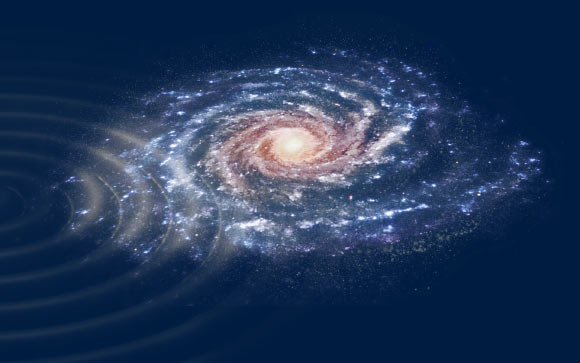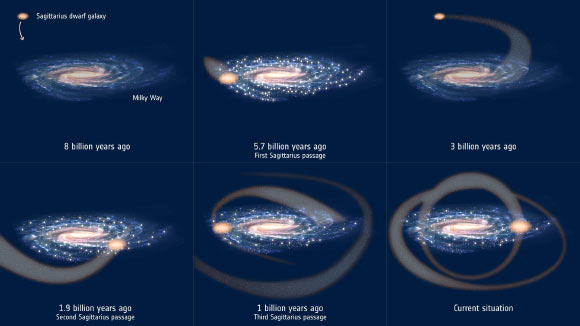Repeated collisions with the Sagittarius dwarf galaxy may have triggered major star formation episodes in our Milky Way Galaxy, one of which roughly coincided with the time of the formation of the Solar System some 4.7 billion years ago, according to an analysis of data from ESA’s star-mapping Gaia satellite.

An artist’s impression of a perturbation in the velocities of stars in the Milky Way Galaxy that was revealed by ESA’s star mapping mission Gaia. Image credit: ESA.
The Sagittarius dwarf galaxy is an elliptical loop-shaped galaxy that is currenly located 78,300 light-years away.
“It is known from existing models that Sagittarius fell into the Milky Way three times — first about 5 or 6 billion years ago, then about 2 billion years ago, and finally one billion years ago,” said Dr. Tomás Ruiz-Lara, an astronomer in the Instituto de Astrofísica de Canarias.
“When we looked into the Gaia data about the Milky Way, we found three periods of increased star formation that peaked 5.7 billion years ago, 1.9 billion years ago and 1 billion years ago, corresponding with the time when Sagittarius is believed to have passed through the disc of the Milky Way.”
Dr. Ruiz-Lara and colleagues looked at luminosities, distances and colors of stars within a sphere of about 6,500 light-years around the Sun and compared the data with existing stellar evolution models.
“At the beginning you have a galaxy, the Milky Way, which is relatively quiet,” Dr. Ruiz-Lara explained.
“After an initial violent epoch of star formation, partly triggered by an earlier merger as we described in a previous study, the Milky Way had reached a balanced state in which stars were forming steadily.”
“Suddenly, you have Sagittarius fall in and disrupt the equilibrium, causing all the previously still gas and dust inside the larger galaxy to slosh around like ripples on the water.”
In some areas of the Milky Way, these ripples would lead to higher concentrations of dust and gas, while emptying others. The high density of material in those areas would then trigger the formation of new stars.
“It seems that not only did Sagittarius shape the structure and influenced the dynamics of how stars are moving in the Milky Way, it has also led to a build-up of the Milky Way,” said co-author Dr. Carme Gallart, also from the Instituto de Astrofísica de Canarias.
“It seems that an important part of the Milky Way’s stellar mass was formed due to the interactions with Sagittarius and wouldn’t exist otherwise.”

The Sagittarius dwarf galaxy has been orbiting the Milky Way for billions for years. As its orbit around the 10,000 more massive Milky Way gradually tightened, it started colliding with our Galaxy’s disk. The three known collisions between Sagittarius and the Milky Way have triggered major star formation episodes, one of which may have given rise to the Solar System. Image credit: ESA.
In fact, it seems possible that even the Sun and its planets would not have existed if the Sagittarius dwarf had not gotten trapped by the gravitational pull of the Milky Way and eventually smashed through its disc.
“The Sun formed at the time when stars were forming in the Milky Way because of the first passage of Sagittarius,” Dr. Carme said.
“We don’t know if the particular cloud of gas and dust that turned into the Sun collapsed because of the effects of Sagittarius or not. But it is a possible scenario because the age of the Sun is consistent with a star formed as a result of the Sagittarius effect.”
The team’s paper was published in the journal Nature Astronomy.
_____
T. Ruiz-Lara et al. The recurrent impact of the Sagittarius dwarf on the star formation history of the Milky Way. Nat Astron, published online May 25, 2020; doi: 10.1038/s41550-020-1097-0







